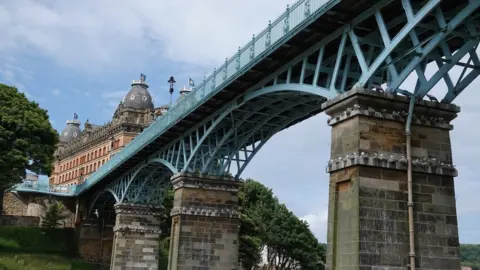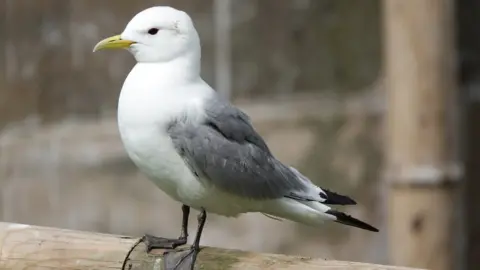Scarborough kittiwakes: Nests removed from Spa Bridge
 Nick Addey
Nick AddeyKittiwake nests have been cleared from a landmark bridge in Scarborough, leaving hundreds of the endangered sea birds homeless, bird watchers said.
Bird deterrent gel has also been added after concerns over excrement damaging the Grade II-listed Spa Bridge, North Yorkshire County Council said.
The council said it had consulted Natural England, which found it would not harm the birds' wider habitat.
Bird watcher Nick Addey is calling for alternative nesting sites to be built.
Kittiwakes are a small type of gull which are on the conservation "red list" and global numbers have fallen by 40% since the 1970s, according to the RSPB.
Mr Addey said the nests can build up over the years as the birds return to the bridge and form new nests on top of old ones.
 Nick Addey
Nick Addey"The nests can be up to about 10in tall, there are some big structures," he said.
"You also get some newer-breeding birds who have the smaller nests. They [council contractors] have cleared all those off, and then they have glued these little tubs of fire gel on, which give off a UV light that the gulls see as a flame so they don't go anywhere near."
Mr Addey said a similar issue had been dealt with near the Tyne Bridge, linking Newcastle upon Tyne and Gateshead, and artificial nesting sites - towers with ledges - had been built to house the displaced birds.
"This is a real opportunity for Scarborough - there is no reason why they couldn't provide one of these towers next to the bridge."
He said many people from the local birdwatching community had complained to the council about the measures, but admitted it was an issue which needed addressing.
"It's quite an issue for the council, kittiwakes are increasing in the town but they have decreased across the UK - that's why we are all upset about it," he said.
North Yorkshire County Council's corporate director for business and environmental services, Karl Battersby, said the impact of the measures would be monitored.
He said: "Before beginning the work, we commissioned an independent habitat assessment, as we are rightly required to do, and consulted Natural England. The conclusion was that the action would not be detrimental to the birds' wider habitat.
"The work was scheduled to avoid a time when birds would be present on the bridge. It involved cleaning off old nest material and excrement, treating with disinfectant and placing small pots of optical gel on the ledges."
He added: "This method was chosen over netting or electrical deterrents, as netting risked entangling birds, as well as being unsightly."

Follow BBC Yorkshire on Facebook, Twitter and Instagram. Send your story ideas to [email protected].
